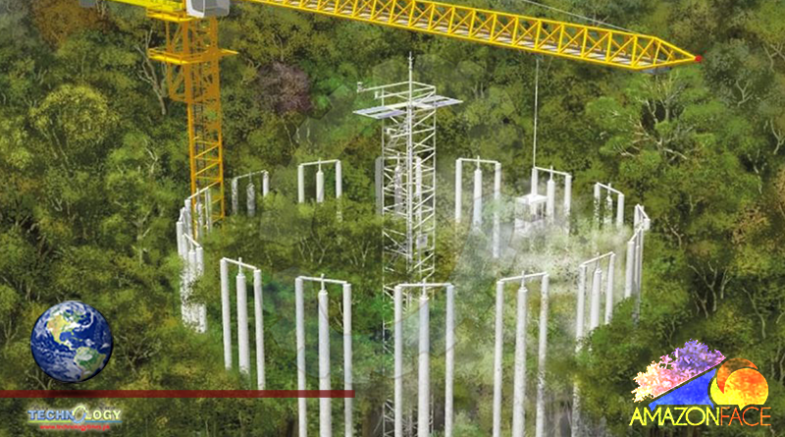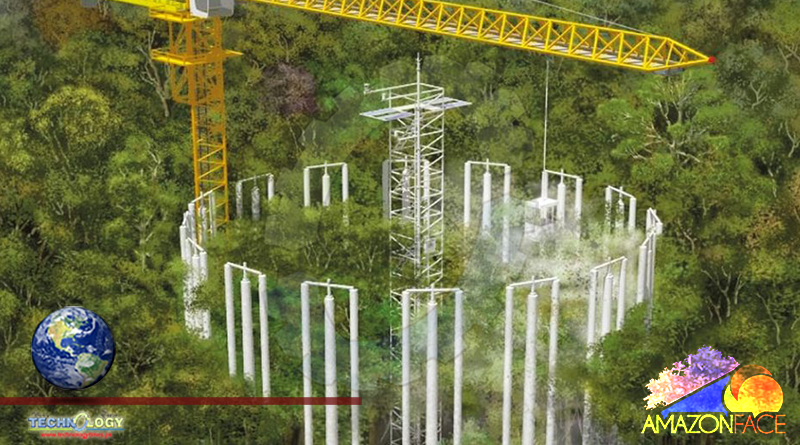AmazonFACE Will Work Like A Time Machine, Artificially Creating The Atmospheric Conditions Projected For 2050

AmazonFACE will be one of the largest open-air laboratories in the world, and it will address a critical gap in international climate science research. The Met Office will work in partnership with Brazil’s National Institute for Amazon Research (INPA) to advance AmazonFACE, a real-world climate experiment to build understanding of how the Amazon forest may respond to environmental change.
Free-Air Carbon Dioxide Enrichment (FACE) experiments pump controlled volumes of carbon dioxide into small areas of forests to simulate its response to climate change. This type of experiment has never been done at scale within a tropical rainforest environment. The Amazon is an important location to analyse because it is crucial to regulating the world’s climate as it absorbs large amounts of carbon dioxide from the atmosphere.
The data collected from the Brazilian-led experiment is vital to help improve carbon budgets and advance climate projection models. Scientists will be able to understand how tropical rainforests should respond in different future scenarios of carbon emissions, addressing a critical gap in international climate science research. With this improved understanding, more detailed solutions for various emissions scenarios can be developed.
AmazonFACE Executive Manager, Professor Beto Quesada, said: “AmazonFACE will inform us about how the Amazon will respond to climate change, how resilient it can be and if future generations will still see the rainforest” Research scientist at the University of Campinas (UNICAMP) and AmazonFACE scientific coordinator David Lapola said: “This is a long-awaited experiment that will be a game-changer on our understanding of the extent to which tropical forests can help humanity abate greenhouse-gas emissions and how vulnerable they are to global climate change.”
Professor Richard Betts MBE, Met Office Fellow and Head of Climate Impacts Research and Chair in Climate Impacts at the University of Exeter said: “AmazonFACE will help us meet the COP26 goals by giving scientists crucial information on how fast carbon dioxide would be removed from the air by the Amazon forest in future. This is critical for calculating the carbon budget for limiting global warming to 1.5°C. We urgently need accurate information on this so we can set emissions reduction targets with confidence.” Forests play a key role in the global cycling of carbon and in the planet’s energy balance with deforestation accounting for around 10% of global CO2 emissions. An importance underlined by a recent international commitment by over 100 leaders to end deforestation by 2030. Reforestation and regrowth have the potential to remove carbon from the atmosphere offsetting unmitigated emissions.
However, one of the great scientific unknowns is how the role of forests could alter in response to climate change. AmazonFACE will work like a time machine, artificially creating the atmospheric conditions projected for 2050, so researchers will be able to analyse how tropical forests respond to increasing atmospheric carbon dioxide concentrations. Dr Andy Wiltshire, Head of Earth System and Mitigation Science, said “The Amazon rainforest is a huge but weakening sink for fossil fuel emissions. AmazonFACE is a unique experiment to help understand how much the Amazon can continue to offset fossil fuel emissions in the future.” The FCDO funded project builds on existing UK-Brazil science and technology collaborations and will also serve to strengthen research in the UK. Through the BIFoR-FACE project near Birmingham, the UK will be able to further develop new large-scale technologies for the forestry and meteorological sectors.
FACE experiments are used successfully in several locations around the world including Staffordshire, UK (BIFoR FACE) and New South Wales, Australia (EucFACE), but never before at scale in tropical forests. Professor Rob MacKenzie, Director of the Birmingham Institute of Forest Research (BIFoR) at the University of Birmingham, said: “We warmly welcome our Amazonian sibling and are already planning how we can combine data from all the forest FACE facilities to uncover the most fundamental results”.
Professor of Terrestrial Ecosystem Science at the University of Exeter Iain Hartley is Chair of the AmazonFACE Scientific Steering Committee. He added: “Rising atmospheric carbon dioxide concentrations have the potential to substantially impact the functioning of Amazon rainforests, with major implications for the indigenous people and biodiversity that rely on them, as well as the critical roles these forests play in regional and global carbon and water cycles.
“However, scientific understanding of likely responses remains limited because, until now, there has been no experiment that has manipulated carbon dioxide concentrations in a tropical rainforest. This major new Brazilian-led project has the potential to be one of the most important global change experiments in the world, and to answer major scientific and socially-relevant research questions in a way that has not previously been possible.”
This news was originally published at Met Office
